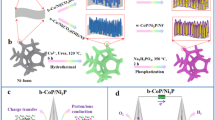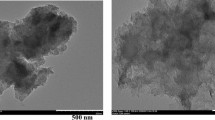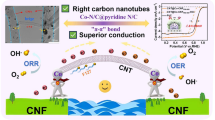Abstract
Herein, we report a facile, bottom-up route to the preparation of N-doped carbons with a high surface area as well as plenty of hierarchical pores by thermal annealing the black bread-like sulfuric acid-dehydrated sucrose. This simple sulfuric acid treatment created a remarkable surface area of 645.7 m2/g in the dehydrated sucrose, and the subsequent thermal annealing with activated reagent ZnCl2 and nitrogen source NH4Cl helped further generated more porous textures in the carbon matrix, which contributes to a high surface area of 2450 m2/g, a large number of hierarchical pores ranging from 2 to 150 nm in a highly porous N-doped carbon to sufficiently expose active sites and boost mass transfer. The best sample N/PC-800, which was thermally annealed at 800 °C, is able to selectively catalyze the 4e− ORR process and shows higher working stability, stronger tolerance to methanol crossover effect, a very comparable onset potential and diffusion-limited current density in alkaline electrolyte, compared to the benchmark Pt/C catalyst. The results in this study signify the validity of present facile, robust template-free method in the synthesis of highly porous N-doped carbons for electrochemical energy conversion and storage.








Similar content being viewed by others
References
Bing Y, Liu H, Zhang L, Ghosh D, Zhang J (2010) Nanostructured Pt-alloy electrocatalysts for PEM fuel cell oxygen reduction reaction. Chem Soc Rev 39:2184
Nie Y, Li L, Wei Z (2015) Recent advancements in Pt and Pt-free catalysts for oxygen reduction reaction. Chem Soc Rev 44:2168
Moreno NG, Molina MC, Gervasio D, Robles JFP (2015) Approaches to polymer electrolyte membrane fuel cells (PEMFCs) and their cost. Renew Sustain Energy Rev 52:897–906
Zhao J, Liu Y, Quan X, Chen S, Yu H, Zhao H (2017) Nitrogen-doped carbon with a high degree of graphitization derived from biomass as high-performance electrocatalyst for oxygen reduction reaction. Appl Surf Sci 396:986
Liew KB, Daud WRW, Ghasemi M, Loh KS, Ismail M, Lim SS, Leong JX (2015) Manganese oxide/functionalised carbon nanotubes nanocomposite as catalyst for oxygen reduction reaction in microbial fuel cell. Int J Hydrogen Energy 40:11625
Bosch-Jimenez P, Martinez-Crespiera S, Amantia D, Pirriera MD, Forns I, Shechter R, Borràs E (2017) Non-precious metal doped carbon nanofiber air-cathode for Microbial Fuel Cells application: oxygen reduction reaction characterization and long-term validation. Electrochim Acta. doi:10.1016/j.electacta.2016.12.175
Tang H, Cai S, Xie S, Wang Z, Tong Y, Pan M, Lu X (2015) Metal–organic-framework-derived dual metal- and nitrogen-doped carbon as efficient and robust oxygen reduction reaction catalysts for microbial fuel cells. Adv Sci 3:1500265
Liew KB, Daud WRW, Ghasemi M, Leong JX, Lim SS, Ismail M (2014) Non-Pt catalyst as oxygen reduction reaction in microbial fuel cells: a review. Int J Hydrogen Energy 39:4870
Zhang J, Zhao Z, Xia Z, Dai L (2015) A metal-free bifunctional electrocatalyst for oxygen reduction and oxygen evolution reactions. Nat Nanotech 10:444–452
Niu W, Li L, Wang N, Zeng S, Liu J, Zhao D, Chen S (2016) Volatilizable template-assisted scalable preparation of honeycomb-like porous carbons for efficient oxygen electroreduction. J Mater Chem A 4:10820
Huang X, Zhao Z, Cao L, Chen Y, Zhu E, Lin Z, Li M, Yan A, Zettl A, Wang YM, Duan X, Mueller T, Huang Y (2015) High-performance transition metal–doped Pt3Ni octahedra for oxygen reduction reaction. Science 348:1230
Bu L, Zhang N, Guo S, Zhang X, Li J, Yao J, Wu T, Lu G, Ma J-Y, Su D, Huang X (2016) Biaxially strained PtPb/Pt core/shell nanoplate boosts oxygen reduction catalysis. Science 354:1410
Escudero-Escribano M, Stephens IEL, Chorkendorff I (2016) Tuning theactivity of Pt alloy electrocatalysts by means of the lanthanide contraction. Science 352:73
Bu L, Guo S, Zhang X, Shen X, Su D, Lu G, Zhu X, Yao J, Guo J, Huang X (2016) Surface engineering of hierarchical platinum-cobalt nanowires for efficient electrocatalysis. Nat Commun 7:11850
He D, Zhang L, Wu Y, Chen C, Li Y (2016) Amorphous nickel boridemembrane on a platinum-nickel alloy surface for enhanced oxygen reductionreaction. Nat Commun 7:12362
Li M, Zhao Z, Cheng T, Fortunelli A, Chen C-Y, Yu R, Zhang Q, Gu L, Merinov B, Lin Z, Zhu E, Yu T, Jia Q, Guo J, Zhang L, Goddard III W, Huang Y, Duan X (2016) Ultrafine jagged platinum nanowires enable ultrahigh mass activity for theoxygen reduction reaction. Science 354:1414
Wang H, Xu S, Tsai C, Li Y, Liu C, Zhao J, Liu Y, Yuan H, Abild-Pedersen F, Prinz FB, Nørskov JK, Cui Y (2016) Direct and continuous strain control of catalysts with tunable battery electrode materials. Science 354:1031
Hunt ST, Milina M, Alba-Rubio AC, Hendon CH, Dumesic JA, Román-Leshkov Y (2016) Self-assembly of noble metal monolayers on transition metal carbide nanoparticle catalysts. Science 352:974
Gong K, Du F, Xia Z, Durstock M, Dai L (2009) Nitrogen-doped carbon nanotube arrays with high electrocatalytic activity for oxygen reduction. Science 323:760
Yang L, Jiang S, Zhao Y, Zhu L, Chen S, Wang X, Wu Q, Ma J, Ma Y, Hu Z (2011) Boron-doped carbon nanotubes as metal-free electrocatalysts for the oxygen reduction reaction. Angew Chem Int Ed 123:7270–7273
Liu Z-W, Peng F, Wang H-J, Yu H, Zheng W-X, Yang J (2011) Phosphorus-doped graphite layers with high electrocatalytic activity for the O2 reduction in an alkaline medium. Angew Chem Int Ed 50:3257–3261
Sun X, Zhang Y, Song P, Pan J, Zhuang L, Xu W, Xing W (2013) Fluorine-doped carbon blacks: highly efficient metal-free electrocatalysts for oxygen reduction reaction. ACS Catal 3:1726
Wang YC, Lai YJ, Song L, Zhou ZY, Liu JG, Wang Q, Yang XD, Chen C, Shi W, Ren YP, Rauf M, Sun SG (2015) S-doping of an Fe/N/C ORR catalyst for polymer electrolyte membrane fuel cells with high power density. Angew Chem Int Ed 54:9907–9910
Kong D, Yuan W, Li C, Song J, Xie A, Shen Y (2017) Synergistic effect of Nitrogen-doped hierarchical porous carbon/graphene with enhanced catalytic performance for oxygen reduction reaction. Appl Surf Sci 393:144
Wu G, More KL, Johnston CM, Zelenay P (2011) High-performance electrocatalysts for oxygen reduction derived from polyaniline, iron, and cobalt. Science 332:443
Zhu C, Li H, Fu S, Du D, Lin Y (2016) Highly efficient nonprecious metal catalysts towards oxygen reduction reaction based on three-dimensional porous carbon nanostructures. Chem Soc Rev 45:517
Liu J, Li L, Niu W, Wang N, Zhao D, Zeng S, Chen S (2016) A hydrogen-bonded organic-framework-derived mesoporous N-doped carbon for efficient electroreduction of oxygen. ChemElectroChem 3:1116–1123
Shui J, Wang M, Du F, Dai L (2015) N-doped carbon nanomaterials are durable catalysts for oxygen reduction reaction in acidic fuel cells. Sci Adv 1:e1400129
Guo C, Tong X, Guo X-Y (2016) Nitrogen-doped mesoporous network-like carbon as an efficient metal-free electrocatalyst for oxygen reduction reaction. Int J Hydrogen Energy 41:22941–22951
Silva R, Voiry D, Chhowalla M, Asefa T (2013) Efficient metal-free electrocatalysts for oxygen reduction: polyaniline-derived N- and O-doped mesoporous carbons. J Am Chem Soc 135:7823–7826
Wei W, Liang H, Parvez K, Zhuang X, Feng X, Müllen K (2014) Nitrogen-doped carbon nanosheets with size-defined mesopores as highly efficient metal-free catalyst for the oxygen reduction reaction. Angew Chem Int Ed 53:1570
Liang C, Li Z, Dai S (2008) Mesoporous carbon materials: synthesis and modification. Angew Chem Int Ed 47:3696–3717
Liang H-W, Wei W, Wu Z-S, Feng X, Müllen K (2013) Mesoporous metal–nitrogen-doped carbon electrocatalysts for highly efficient oxygen reduction reaction. J Am Chem Soc 135:16002–16005
Bayatsarmadi B, Zheng Y, Jaroniec M, Qiao SZ (2015) Soft-templating synthesis of N-doped mesoporous carbon nanospheres for enhanced oxygen reduction reaction. Chem Asian J 10:1546
Liang H-W, Zhuang X, Brüller S, Feng X, Müllen K (2014) Hierarchically porous carbons with optimized nitrogen doping as highly active electrocatalysts for oxygen reduction. Nat Commun 5:4973
Wan K, Liu M-Y, Yu Z-P, Liang Z-X, Liu Q-B, Piao J-H, Zheng Y-Y (2016) Synthesis of nitrogen-doped ordered mesoporous carbon electrocatalyst: nanoconfinement effect in SBA-15 template. Int J Hydrogen Energy 41:18027–18032
Kim D-Y, Nishiyama Y, Wada M, Kuga S (2001) High-yield carbonization of cellulose by sulfuric acid impregnation. Cellulose 8:29
Karagöz S, Tay T, Ucar S, Erdemb M (2008) Activated carbons from waste biomass by sulfuric acid activation and their use on methylene blue adsorption. Bioresour Technol 99:6214–6222
Davis RE, Horvath GL, Tobias CW (1967) Electrochim Acta 12:287
Clouser SJ, Huang JC, Yeager E (1993) Temperature dependence of the Tafel slope for oxygen reduction on platinum in concentrated phosphoric acid. J Appl Electrochem 23:597
Wang G, Peng H, Qiao X, Du L, Li X, Shu T, Liao S (2016) Biomass-derived porous heteroatom-doped carbon spheres as a high-performance catalyst for the oxygen reduction reaction. Int J Hydrogen Energy 41:14101–14110
Chen P, Wang L-K, Wang G, Gao M-R, Ge J, Yuan W-J, Shen Y-H, Xie A-J, Yu S-H (2014) Nitrogen-doped nanoporous carbon nanosheets derived from plant biomass: an efficient catalyst for oxygen reduction reaction. Energy Environ Sci 7:4095
Liu X, Li L, Zhou W, Zhou Y, Niu W, Chen S (2015) High-performance electrocatalysts for oxygen reduction based on nitrogen-doped porous carbon from hydrothermal treatment of glucose and dicyandiamide. ChemElectroChem 2:803–810
Ding W, Li L, Xiong K, Wang Y, Li W, Nie Y, Chen S, Qi X, Wei Z (2015) Shape fixing via salt recrystallization: a morphology-controlled approach to convert nano-structured polymer to carbon nanomaterial as a high active catalyst for oxygen reduction reaction. J Am Chem Soc 137:5414–5420
Sanetuntikul J, Chuaicham C, Choi Y-W, Shanmugam S (2015) Investigation of hollow nitrogen-doped carbon spheres as non-precious Fe–N4 based oxygen reduction catalysts. J Mater Chem A 3:15473
Robson MH, Serov A, Artyushkova K, Atanassov P (2013) A mechanistic study of 4-aminoantipyrine and iron derived non-platinum group metal catalyst on the oxygen reduction reaction. Electrochim Acta 90:656–665
Wang N, Niu W, Li L, Liu J, Tang Z, Zhou W, Chen S (2015) Oxygen electroreduction promoted by quasi oxygen vacancies in metal oxide nanoparticles prepared by photoinduced chlorine doping. Chem Commun 51:10620–10623
Xu J, Gao P, Zhao TS (2012) Non-precious Co3O4 nano-rod electrocatalyst for oxygen reduction reaction in anion-exchange membrane fuel cells. Energy Environ Sci 5:5333–5339
Alatalo S-M, Qiu K, Preuss K, Marinovic A, Sevilla M, Sillanpää M, Guo X, Titiric M-M (2016) Soy protein directed hydrothermal synthesis of porous carbon aerogels for electrocatalytic oxygen reduction. Carbon 96:622
Latham KG, Jambu G, Joseph SD, Donne SW (2014) Nitrogen doping of hydrochars produced hydrothermal treatment of sucrose in H2O, H2SO4, and NaOH. ACS Sustain Chem Eng 2:755
Liu T, Liu E, Ding R, Luo Z, Hu T, Li Z (2015) Preparation and supercapacitive performance of clew-like porous nanocarbons derived from sucrose by catalytic graphitization. Electrochim Acta 173:50–58
Nunes M, Rocha IM, Fernandes DM, Mestre AS, Moura CN, Carvalho AP, Pereira MFR, Freire C (2015) Sucrose-derived activated carbons: electron transfer properties and application as oxygen reduction electrocatalysts. RSC Adv 5:102919
Sun Y, Wu J, Tian J, Jin C, Yang R (2015) Sulfur-doped carbon spheres as efficient metal-free electrocatalysts for oxygen reduction reaction. Electrochim Acta 178:806–812
Guo C, Tong X, Guo X-Y (2016) Nitrogen-doped mesoporous network-like carbon as an efficient metal-free electrocatalyst for oxygen reduction reaction. Int J Hydrogen Energy 41:22941–22951
Guo C, Liao W, Li Z, Sun L, Chen C (2015) Easy conversion of protein-rich enoki mushroom biomass to nitrogen-doped carbon nanomaterial as a promising metal-free catalyst for oxygen reduction reaction. Nanoscale 7:15990
Lin L, Zhu Q, Xu A-W (2014) Noble-metal-free Fe–N/C catalyst for highly efficient oxygen reduction reaction under both alkaline and acidic conditions. J Am Chem Soc 136:11027
Liu Q, Wang Y, Dai L, Yao J (2016) Scalable fabrication of nanoporous carbon fiber films as bifunctional catalytic electrodes for flexible Zn-Air batteries. Adv Mater 28:3000
Meng F, Zhong H, Bao D, Yan J, Zhang X (2016) In situ coupling of strung Co4N and intertwined N-C Fibers towards free-standing bifunctional cathode for robust, efficient, and flexible Zn-air batteries. J Am Chem Soc 138:10226
Zhu H, Yin J, Wang X, Wang H, Yang X (2013) Microorganism-derived heteroatom-doped carbon materials for oxygen reduction and supercapacitors. Adv Funct Mater 23:1305–1312
Shcherban N, Filonenko S, Yaremov P, Dyadyun V, Bezverkhyy I, Ilyin V (2017) Boron-doped nanoporous carbons as promising materials for supercapacitors and hydrogen storage. J Mater Sci 52:1523–1533. doi:10.1007/s10853-016-0447-x
Zhang C, Lin S, Peng J, Hong Y, Wang Z, Jin X (2017) Preparation of highly porous carbon through activation of NH4Cl induced hydrothermal microsphere derivation of glucose. RSC Adv 7:6486
Xu Z, Liu Y, Chen H, Yang M, Li H (2017) Bamboo-like, oxygen-doped carbon tubes with hierarchical pore structure derived from polymer tubes for supercapacitor applications. J Mater Sci 52:7781–7793. doi:10.1007/s10853-017-1064-z
Li G, Sun J, Hou W, Jiang S, Huang Y, Geng J (2016) Three-dimensional porous carbon composites containing high sulfur nanoparticle content for high-performance lithium–sulfur batteries. Nat Commun 7:10601
Zhou X, Liao Q, Bai T, Yang J (2017) Rational design of graphene @ nitrogen and phosphorous dual-doped porous carbon sandwich-type layer for advanced lithium–sulfur batteries. J Mater Sci 52:7719–7732. doi:10.1007/s10853-017-1029-2
Acknowledgements
This work was supported by the National Natural Science Foundation of China (NSFC 51402111 and NSFC 21373061), Guangdong Innovative and Entrepreneurial Research Team Program (2014ZT05N200) and the Key Project for Natural Science Foundation of Guangdong Province (2014A030311038, 2016A030313733).
Author information
Authors and Affiliations
Corresponding authors
Rights and permissions
About this article
Cite this article
Wu, J., Liu, J., Li, L. et al. A bottom-up, template-free route to mesoporous N-doped carbons for efficient oxygen electroreduction. J Mater Sci 52, 9794–9805 (2017). https://doi.org/10.1007/s10853-017-1165-8
Received:
Accepted:
Published:
Issue Date:
DOI: https://doi.org/10.1007/s10853-017-1165-8




